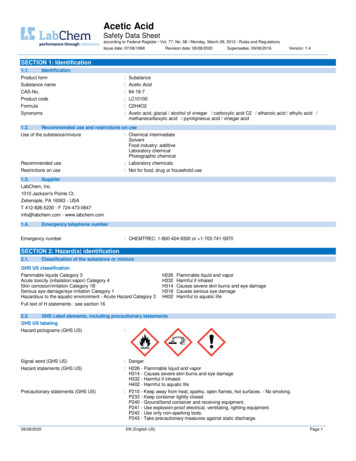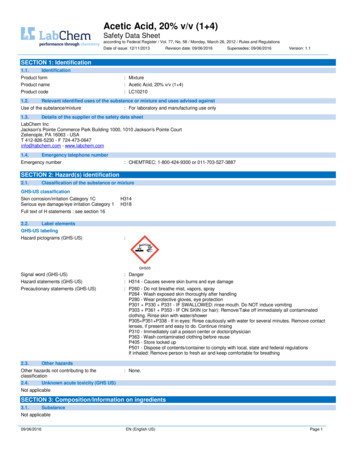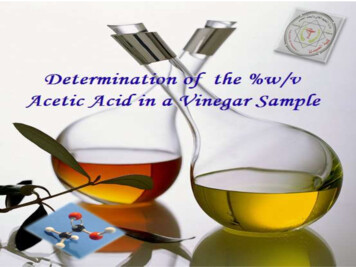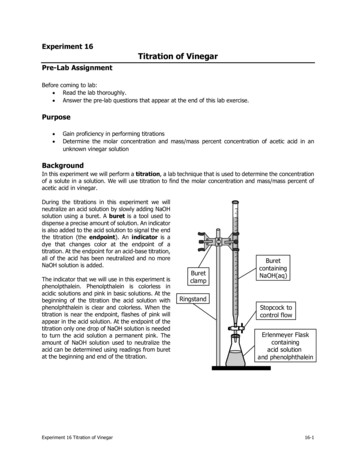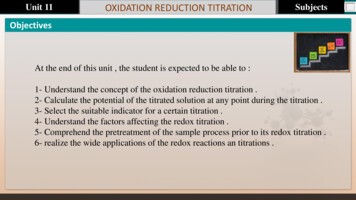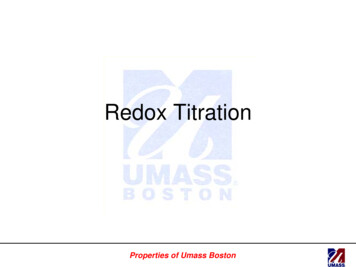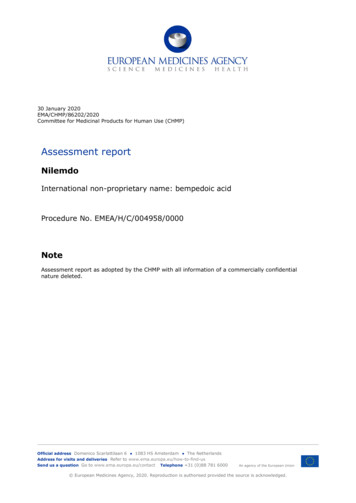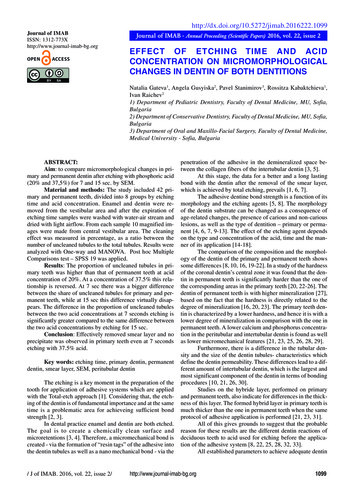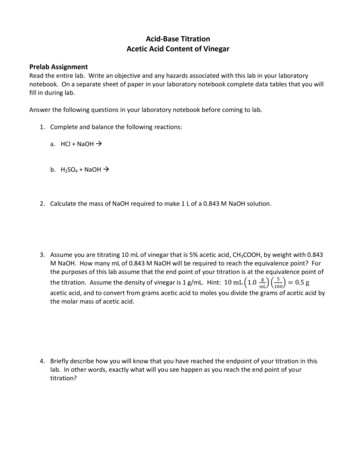
Transcription
Acid-Base TitrationAcetic Acid Content of VinegarPrelab AssignmentRead the entire lab. Write an objective and any hazards associated with this lab in your laboratorynotebook. On a separate sheet of paper in your laboratory notebook complete data tables that you willfill in during lab.Answer the following questions in your laboratory notebook before coming to lab.1. Complete and balance the following reactions:a. HCl NaOH b. H2SO4 NaOH 2. Calculate the mass of NaOH required to make 1 L of a 0.843 M NaOH solution.3. Assume you are titrating 10 mL of vinegar that is 5% acetic acid, CH3COOH, by weight with 0.843M NaOH. How many mL of 0.843 M NaOH will be required to reach the equivalence point? Forthe purposes of this lab assume that the end point of your titration is at the equivalence point ofthe titration. Assume the density of vinegar is 1 g/mL. Hint:acetic acid, and to convert from grams acetic acid to moles you divide the grams of acetic acid bythe molar mass of acetic acid.4. Briefly describe how you will know that you have reached the endpoint of your titration in thislab. In other words, exactly what will you see happen as you reach the end point of yourtitration?
Acid-Base TitrationAcetic Acid Content of VinegarsIntroductionAcids and BasesAcids are a class of substances that have similar chemical properties. Acids react with metals to formhydrogen gas. Acids produce carbon dioxide gas when they react with compounds containing carbonatesuch as limestone. Some dilute acids are common in foods, usually causing a sour taste. Citric andacetic acids are examples of weak acids found in food. You may also have strong acids, such as sulfuricacid, in your car’s battery. Different acids have similar chemical properties because they contain andrelease H in aqueous solution.Bases are another class of substances with similar chemical properties. One of the properties of bases isthat they react with vegetable oils and fats to make soap. Bases feel slippery to the touch becauseconcentrated bases dissolve skin. Ammonia is a common weak base found in household cleaners. Manydrain openers or cleaners contain strong bases such as sodium hydroxide. Bases have similar propertiesbecause they cause hydroxide ions, OH-, to be present in aqueous solution.IndicatorsHow can we tell if a solution is acidic or basic? One method is to use a chemical called an indicator.Indicators exhibit one color in an acidic solution and a different color in a basic solution. Commonindicators include methyl red, which changes from yellow in solutions above a pH of between 4.4 and6.2 to red as solutions decrease below this pH range, and phenolphthalein, which changes from clear insolutions below a pH of between 8 and 10 to bright pink as solutions increase above this pH range.TitrationsA titration is an analytical technique used to determine the concentration of a substance in solution byadding an accurately measured volume of a solution of known concentration, called a titrant, whichreacts through known stoichiometry with the substance of unknown concentration.Titrations are often carried out by adding a base of known concentration to an acid, or by adding an acidof known concentration to a base. The net ionic equation for the reaction of a strong acid with a strongbase isH (aq) OH-(aq) H2O(l),and is called neutralization. At the endpoint of an acid-base titration the number of moles of acid orbase added has reacted with or neutralized exactly the same number of moles of acid or base in thesample. In other words, at the end pointmoles acid or base added moles acid or base in the solution of unknown concentration.The characteristics of the solution being titrated will change dramatically at this point, and a vivid colorchange in an appropriately selected indicator should occur.The volume of the titrant added during the titration must be carefully controlled and measured. This isdone using a buret. Examine the buret carefully before use. Notice that the graduations on the buret
are 0.0 mL near the top and increase to 50.0 mL as you move down the buret. Recall that when readingthe level of liquid in a buret, always read the lowest point on the meniscus and all readings should betaken at eye level. By interpolating (estimating the values between the markings on the buret), it ispossible to determine volumes to an accuracy of 0.01 mL.The volume of titrant added at the end point of the titration is the final buret reading minus the initialburet reading. Titrant is released from the buret by turning the stop cock near the bottom tip of theburet. The stop cock is closed when it is perpendicular to the long cylinder of the buret. As you slowlyturn the stop cock toward a parallel alignment with the cylinder of the buret titrant will first begin todrip then flow in a steady stream. You may wish to practice using the buret before you begin a titration.VinegarVinegar is a dilute solution of acetic acid in water, and is made from fruit juices. The chemical changesinvolved in the formation of vinegar are the fermentation of sugar to alcohol by yeast followed by thesubsequent oxidation of the alcohol to acetic acid by certain bacteria.The United States Department of Agriculture specifies that the organic acid content of vinegar(expressed as acetic acid) must be at least 4 % by weight. The commercial vinegars that we will be usingtoday all list the acetic acid content as approximately 5 %.The acetic acid content or acidity of vinegar can be calculated from the neutralization reaction of aceticacid using a base of known concentration. We will perform a titration with a 0.843 M NaOH solution.Neutralization occurs when the moles of acid equals the moles base in the titration vessel. The reactionisCH3COOH NaOH H2O CH3COONaNote that in the balanced equation, one mole of acetic acid exactly neutralizes one mole of sodiumhydroxide to give water and sodium acetate. To make the endpoint (where the moles of acid equal themoles of base) visible we will add phenolphthalein indicator to the unknown acid solution.Phenolphthalein is colorless in acidic solution (where it is protonated) and pink in basic solution (wherethe H dissociates). You should mark the endpoint at the FIRST appearance of CONSISTENT pink color(color persists for 20-30 seconds with mixing), not after you have developed a deep pink or red color.Procedure1) Wash the buret with soap and water. After washing, thoroughly rinse the buret with tap waterand then with small amounts ( 2-5 mL) of distilled water. Close the stopcock and pour about 2mL of NaOH solution into the buret using a funnel. Rotate the buret in a nearly horizontal
position in order to rinse the interior of the buret with base solution. Wear gloves and hold afinger over the end of the buret to rinse it. Place the buret into the buret clamp and drain therinse solution form the buret into a small beaker (for waste).2) Close the stopcock and use a funnel to fill the buret with base solution to between 15 and 20 mLfrom the top. Record the exact volume of base in your lab notebook as your initial reading. Allburet readings should be made to two decimal places (for example, 1.05 mL)3) Add 10 mL of vinegar to a 250 mL Erlenmeyer flask using a graduated cylinder. Add about 75 mLof distilled water and 5 to 6 drops of phenolphthalein indicator to the flask. Shake the bottle ofphenolphthalein before use.4) Titrate the vinegar solution by carefully adding titrant. Gently swirl the vinegar solution in theflask while titrating. Place a piece of white paper under your flask to make the color change atthe endpoint easier to see. You may add titrant more quickly at first. Recall that you estimatedapproximately how much titrant will be required to reach the endpoint in your prelab. As younear the endpoint of your titration add titrant much more slowly – drop by drop – as you gentlyswirl the sample and carefully watch for the color change. You will see a pink spot appear wherethe titrant first falls into the vinegar solution as you near the end point. The pink spot will
disappear with swirling. When the pink color spreads to the entire solution and persists for 2030 seconds, you have reached the endpoint. If you pass the endpoint you must start over fromthe beginning.5) Record the volume of titrant remaining in the buret at the endpoint. Continue to add titrant untilthe vinegar solution turns bright pink to verify that you have passed the endpoint.6) Repeat the titration with another 10 mL of vinegar with 75 mL of distilled water.
Copy the following data sheet into your lab notebook.Data SheetNaOH Molarity moles/LRep 1Rep 2Initial buret readingFinal buret readingNaOH used, mLNaOH used, LMoles of NaOH usedRecall moles M VMoles of AceticAcid in TitrationFlask(Recall that at the equivalence point moles base added moles acid in the sample)Molarity (M moles/L) ofAcetic Acid in VinegarGrams of AceticAcid in Vinegar(Recall that to convert moles to grams you multiply by the molar mass)Weight Percent* ofAcetic Acid(Weight percent of acetic acid in vinegar is the mass of a acetic acid in a vinegar sample divided by thetotal mass of the sample, multiplied by 100)*Assume the density of vinegar is 1 g/mL.
Questions1) Based on your results does the vinegar you titrated meet the US Department of Agriculturestandards?2) Based on your results is the percent by weight of acetic acid indicated on the label of the vinegaryou titrated correct?3) How would you design an experiment to analyze for the percentage of NH3(aq) in commercialammonia? Consider the procedure you used in this lab. Be specific: list at least 5 steps in theprocedure; include sample size, identity of titrant, and any indicators utilized.
Acetic Acid Content of Vinegar Prelab Assignment Read the entire lab. Write an objective and any hazards associated with this lab in your laboratory notebook. On a separate sheet of paper in your laboratory notebook complete data tables that you will fill in during lab. Answer the following questions in your laboratory notebook before coming to lab. 1. Complete and balance the following .

